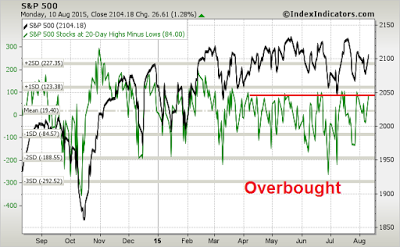by Cam Hui, Humble Student of the Markets
In my last blog post written on Sunday (see You can't hurry tops!), I had postulated a rally to test the old SPX highs and possibly make marginal new highs. The market promptly went up on Monday. Overnight, the PBoC announced a 1.9% devaluation of the RMB against the USD. The market interpreted the move as panic by the policy makers in Beijing and a general risk-off environment followed.
We know that we can't anticipate central bank interventions and announcements, but we can learn about the character of the market by the way it reacts to news. In my last post, I wrote that I would be watching the relative performance of the leadership sectors, namely Financials, Consumer Discretionary and Health Care, which comprise over 50% of the weight of the SPX. As long as the relative strength of these sectors held up, the bull case was intact.
Here is what has happened. As the chart below shows, the relative uptrend of Financial stocks (top panel) remains intact. However, the short-term relative uptrends (dotted lines) of Consumer Discretionary (second panel) and Health Care (third panel) stocks were violated. Their longer term uptrends, however, remain intact.
While these developments are discouraging for the bull case, there is a silver lining. The relative uptrend of the high beta momentum stocks is still in place. In fact, momentum stocks outperformed on Tuesday even as the market got clobbered.
We can see this effect by the way the market reacted to the corporate reorganization at Google, whose stock price soared on Tuesday despite the negative tone of the market. Felix Salmon wrote about the bullish and bearish points to the reorganization. Here is a sample of the more bearish elements.
B is for boredom. Larry is the founder and CEO of one of the most successful companies on planet Earth, but the company more or less runs itself at this point, and Larry doesn’t want to be judged on margins and earnings and boring things like that. He wants to be “in the business of starting new things.” So he’s handing over Google, along with all of its management headaches, to Sundar Pichai. And he’s keeping the sexy entrepreneurial stuff for himself.
I is for impossible, and the dreaming thereof. Shareholders don’t like that kind of thing, but Larry is clear that he doesn’t answer to shareholders.
M is for management. Larry doesn’t know how to manage Google. Google – the entity which is being taken over by Pichai – is already a hydra-headed beast, encompassing not only search but also other multi-billion-dollar businesses including Maps, Chrome, YouTube, and (oh, yeah) the world’s biggest mobile operating system, Android. Keeping all those moving parts working in some vague sync is very, very hard work, and it’s not clear that Larry Page is the person to do it. Giving Pichai the job could mean that Google becomes more successful than it would otherwise have been.
Q is for quixotic. Larry can change Google’s name, but he can’t change its business. Google will continue to drive Alphabet’s business, and its reputation, for the foreseeable future, and for most purposes it will continue to make sense to consider the two to be identical. Everything else – Alphabet minus Google, essentially – is a “Larry tax”. At least unless and until it starts paying off.
V is for Valleythink. A company as large, vague, and ambitious as Alphabet could only exist in Silicon Valley. The financial idea is that the enormous profits flowing out of Google will then get reinvested into thousands of other businesses – partly through Google Capital and Google Ventures, which are separate Alphabet subsidiaries. No one whose name isn’t Warren Buffett has managed to sustain this model. And Warren Buffett isn’t investing in an attempt to change the world and make trillions of dollars, he’s investing for predictable returns.
The market could have interpreted the reorganization as the company had grown too large for Larry Page to manage. He just wants to transform it into a conglomerate (which only people like Warren Buffett has managed successfully) and Page just wants to use Google's cash flows to fund his special projects such as self-driving cars and human longevity. (Don't forget how acquisitions like Zagat's worked out.)
The positive market reaction to the reorganization news is still an indication that the bulls are still in control of the tape, though barely. The bull scenario of the market testing old highs and making new highs is therefore still in play.
Short-term reaction
Despite my mild bullishness for the next few weeks, I would remain cautious on stock prices for the next several days. These are the breadth readings of net 20-day highs-lows for the SPX as of Monday`s close (before Tuesday`s selloff), which indicated that the market was overbought and due for a pullback (via IndexIndicators):
Despite the weakness seen on Tuesday, RSI readings are nowhere near oversold levels where we might see a bounce. I would therefore anticipate that the SPX would break down through the triangle depicted below and test support, first at the 2065-2070 level, and possibly further support at about 2040.
The downside move is likely to be short and sharp. My inner trader moved to cash Tuesday morning. He doesn't believe he is nimble enough to play the short side and he would prefer to wait for oversold readings to take a long position.
Copyright © Humble Student of the Markets


















